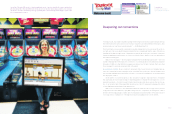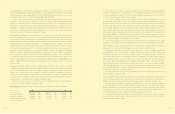Yahoo 2001 Annual Report Download - page 21
Download and view the complete annual report
Please find page 21 of the 2001 Yahoo annual report below. You can navigate through the pages in the report by either clicking on the pages listed below, or by using the keyword search tool below to find specific information within the annual report.
accounting used in previous business combinations initiated prior to July 1, 2001, including those we
accounted for under the pooling-of-interests method.
In July 2001, the FASB also issued SFAS 142, which is effective for fiscal years beginning after
December 15, 2001. Certain provisions also apply to acquisitions initiated subsequent to June 30, 2001.
SFAS 142 supercedes APB Opinion No. 17 “Intangible Assets” and requires, among other things, the dis-
continuance of amortization related to goodwill and indefinite lived intangible assets. These assets will
then be subject to an impairment test at least annually. In addition, the statement includes provisions
upon adoption for the reclassification of certain existing recognized intangibles as goodwill, the identifi-
cation of reporting units for the purpose of assessing potential future impairments of goodwill, the
reassessment of the useful lives of existing recognized intangibles, and reclassification of certain intan-
gibles out of previously reported goodwill.
We will adopt SFAS 142 effective January 1, 2002, which will result, among other items, in no longer
amortizing existing goodwill. At December 31, 2001 and 2000, goodwill approximated $193.0 million
and $74.8 million, respectively, and goodwill amortization approximated $53.2 million, $19.7 million, and
$9.8 million for 2001, 2000, and 1999. We expect that approximately $50 million to $100 million of good-
will will be impaired upon the adoption of SFAS 142 in connection with the transition impairment tests
which are required to be completed no later than December 31, 2002. The impairment resulting from these
transition tests will be recorded as of January 1, 2002 and will be recognized as the cumulative effect of
a change in accounting principle. We expect to complete the impairment loss measurement by March 31,
2002.
In October 2001, the FASB issued Statement of Financial Accounting Standards No. 144 (“SFAS 144”),
“Accounting for the Impairment or Disposal of Long-Lived Assets,” which supercedes SFAS 121 and cer-
tain provisions of APB Opinion No. 30, “Reporting Results of Operations – Reporting the Effects of Disposal
of a Segment of a Business, and Extraordinary, Unusual and Infrequently Occurring Events and
Transactions.” SFAS 144 requires that long-lived assets to be disposed of by sale, including discontinued
operations, be measured at the lower of carrying amount or fair value less cost to sell, whether reported
in continuing operations or in discontinued operations. SFAS 144 also broadens the reporting requirements
of discontinued operations to include all components of an entity that have operations and cash flows that
can be clearly distinguished, operationally and for financial reporting purposes, from the rest of the entity.
The provisions of SFAS 144 are effective for fiscal years beginning after December 15, 2001. We are eval-
uating the effect of this statement on our results of operations and financial position.
Liquidity and Capital Resources
In summary our cash flows were (in thousands):
2001 2000 1999
Cash provided by operating activities $ 106,850 $ 509,707 $ 204,496
Cash used in investing activities (207,173) (679,144) (451,495)
Cash provided by financing activities 18,290 355,279 284,147
We invest excess cash predominantly in debt instruments that are highly liquid, of high-quality investment
grade, and predominantly have maturities of less than two years with the intent to make such funds read-
ily available for operating purposes. As of December 31, 2001, we had cash, cash equivalents, and invest-
ments in marketable debt securities totaling approximately $1.5 billion compared to approximately $1.7
YHOO39YHOO38
billion and $1.0 billion as of December 31, 2000 and 1999, respectively. Restricted cash and restricted
long-term investments amounted to $258.7 million and $30.0 million as of December 31, 2001 and 2000.
Cash provided by operating activities primarily consists of net income (loss) adjusted for certain non-
cash items including depreciation, amortization, tax benefits from stock options, net investment losses,
restructuring costs and other non-cash items, and the effect of changes in working capital and other activ-
ities. Cash provided by operating activities in 2001 of $106.9 million consisted primarily of a net loss of
$92.8 million adjusted for non-cash items of $185.2 million and $14.4 million provided by working capi-
tal and other activities. Cash provided by operating activities in 2000 of $509.7 million consisted prima-
rily of net income of $70.8 million adjusted for non-cash items of $386.4 million and $52.5 million provided
by working capital and other activities. Cash provided by operating activities in 1999 of $204.5 million
consisted primarily of net income of $47.8 million adjusted for non-cash items of $98.8 million and $57.9
million provided by working capital and other activities.
Cash used in investing activities in 2001 of $207.2 million was primarily attributable to proceeds
from sales and maturities (net of purchases) of investments in marketable securities during the year of
$128.5 million, the $30.0 million release of collateralized amounts, offset by an increase in restricted
investments related to our leased facilities of $258.7 million, capital expenditures totaling $86.2 million,
and cash used in acquisitions and purchases of other investments (net) of $20.8 million. Capital expen-
ditures have generally been comprised of purchases of computer hardware, software, server equipment,
and furniture and fixtures, and are currently expected to modestly decrease in 2002 as we further man-
age discretionary spending. For 2000, cash used in investing activities was $679.1 million. Purchases
(net of sales and maturities) of investments in marketable securities during the year were $473.0 million,
purchase of restricted investments was $30.0 million, capital expenditures totaled $94.4 million, and cash
used in acquisitions and purchases of other investments (net) was $81.7 million. For 1999, cash used in
investing activities was $451.5 million. Purchases (net of sales and maturities) of investments in mar-
ketable securities, acquisitions, and other investments during the period were $399.1 million and capital
expenditures totaled $52.4 million.
Cash provided by financing activities in 2001 of $18.3 million was primarily due to proceeds from the
issuance of Common Stock pursuant to stock option exercises of $83.9 million, offset by Common Stock
repurchases of $60.0 million and other financing activities of $5.6 million. For 2000, cash provided by
financing activities was $355.3 million, primarily due to proceeds from the issuance of Common Stock pur-
suant to stock option exercises. For 1999, cash provided by financing activities was $284.1 million and
was primarily due to proceeds from the issuance of Common Stock pursuant to stock option exercises.
Operating Leases. During 1999, we entered into agreements for the development of an office complex in
Sunnyvale, California to serve as our headquarters. Construction was completed in the third quarter of
2001. Upon substantial completion of the construction, we funded the lease facility with deposited funds
drawn on the facility by the lessors. The total amount funded was approximately $258.7 million.
Approximately $222.4 million of this amount represents an investment in the lease facility resulting from
our role as a participant in the master lease facility. The remaining $36.3 million represents collateral for
funds provided by the facility’s other participants. These amounts have been classified as restricted long-
term investments at December 31, 2001. Rent obligations for the complex bear a direct relationship to
the lessor’s carr ying costs of $258.4 million. The lease provides us with the option at the end of the lease
term in 2006 to (i) acquire the buildings for an amount equal to the lessor’s carrying costs; (ii) re-mar-
ket the buildings; or (iii) renew the lease for a second, five-year term, upon written consent of the par-
























